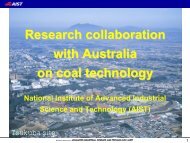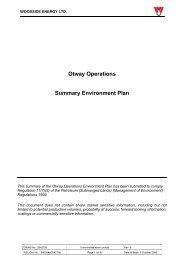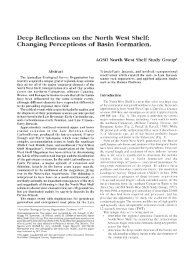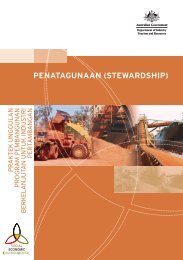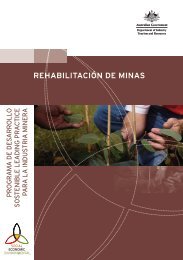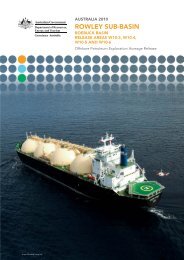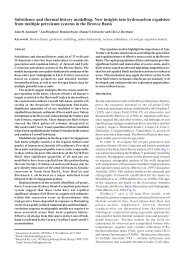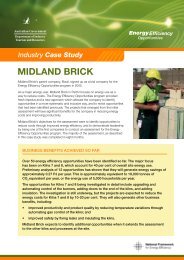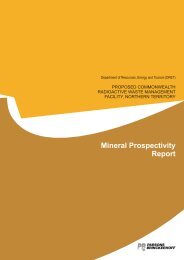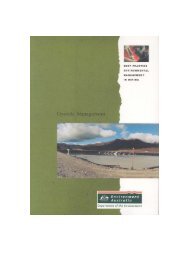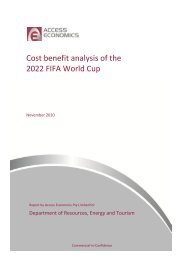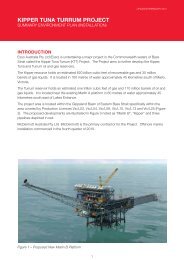A guide to leading practice sustainable development in mining
A guide to leading practice sustainable development in mining
A guide to leading practice sustainable development in mining
Create successful ePaper yourself
Turn your PDF publications into a flip-book with our unique Google optimized e-Paper software.
MINE: Berong Nickel Project (Berong Nickel Corporation).<br />
LOCATION: Palawan, Region 4B, the Philipp<strong>in</strong>es<br />
BRIEF DESCRIPTION: Surface Nickel M<strong>in</strong><strong>in</strong>g; Direct Shipp<strong>in</strong>g Operation<br />
AREA OF LEADING PRACTICE: Susta<strong>in</strong>able Development, Progressive<br />
Rehabilitation, Re-vegetation Research Design and Practices<br />
HANDBOOK(S) REFERENCE: M<strong>in</strong>e Rehabilitation<br />
DESCRIPTION OF INNOVATION: Applied Rehabilitation Research,<br />
Rehabilitation Strategies<br />
The Berong Nickel Project (BNC) is located on the Island of Palawan, the<br />
Philipp<strong>in</strong>es. BNC is firmly committed <strong>to</strong> best <strong>practice</strong> <strong>in</strong> environmental<br />
management, with a strong emphasis on sound social responsibility. Part of<br />
this commitment is progressive rehabilitation of the m<strong>in</strong>ed areas <strong>to</strong> provide<br />
<strong>susta<strong>in</strong>able</strong> outcomes.<br />
His<strong>to</strong>rically, successful revegetation of m<strong>in</strong>ed nickel operations has been<br />
difficult due <strong>to</strong> the highly leached nature of the lateritic soils <strong>in</strong> high ra<strong>in</strong>fall<br />
regions (equa<strong>to</strong>rial belt) <strong>lead<strong>in</strong>g</strong> <strong>to</strong> nutrient deficient soils. This is further<br />
reduced with the removal of the th<strong>in</strong> <strong>to</strong>p soil layer and predom<strong>in</strong>ant ore body.<br />
The type of vegetation that has grown can be considered low <strong>in</strong> value <strong>in</strong> terms<br />
of ecological susta<strong>in</strong>ability or economic return <strong>to</strong> the communities of the<br />
region.<br />
To determ<strong>in</strong>e what would provide the possible long term solution <strong>to</strong><br />
rehabilitation, <strong>in</strong> August 2007, BNC established a rehabilitation research<br />
project <strong>in</strong> the first m<strong>in</strong>ed area– Area 4. 106 – 10mx10m research plots<br />
were established on three benches <strong>to</strong> determ<strong>in</strong>e the best possible land<br />
forms, grow<strong>in</strong>g mediums and species selection tak<strong>in</strong>g <strong>in</strong><strong>to</strong> consideration<br />
the requirements and desires of the community post m<strong>in</strong><strong>in</strong>g <strong>in</strong> terms of<br />
alternative land use.<br />
Based on discussions with the community, it was decided that Parra<br />
Rubber would form the predom<strong>in</strong>ant species for the next, pilot stage of the<br />
project with a mix of Narra and Agoho. The Para rubber species and other<br />
establishment species such as Narra (high value timber used <strong>in</strong> commercial<br />
manufactur<strong>in</strong>g) and Palawan Agoho (fast grow<strong>in</strong>g which provides a visual<br />
buffer) will be used <strong>in</strong> comb<strong>in</strong>ation <strong>to</strong> provide greenways and buffers <strong>in</strong> the<br />
design and plant<strong>in</strong>g strategies. Parra Rubber was found <strong>to</strong> be the sturdiest<br />
<strong>in</strong> terms of survival and growth. The community support the establishment<br />
of Parra Rubber as it will provide a post m<strong>in</strong><strong>in</strong>g <strong>in</strong>come and <strong>in</strong>dustry. It is<br />
expected that the species will prosper with amelioration strategies such as<br />
the correct fertilizer application, soil amendments and constant management<br />
dur<strong>in</strong>g the first 7 years of growth. It is expected that there will be a return on<br />
<strong>in</strong>vestment after 7 years, so management through this stage is critical.<br />
* contributed by: Dr Keith Halford<br />
160 LEADING PRACTICE SUSTAINABLE DEVELOPMENT PROGRAM FOR THE MINING INDUSTRY



